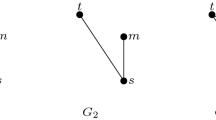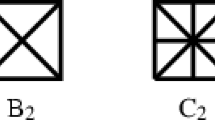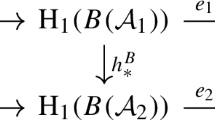Abstract
Building on work of Brandt and Terao in their study of k-formality, we introduce a co-chain complex associated to a multi-arrangement and prove that its cohomologies determine freeness of the associated module of multi-derivations. This provides a new homological method for determining freeness of arrangements and multi-arrangements. We work out many applications of this homological method. For instance, we prove that if a multi-arrangement is free then the underlying arrangement is k-formal for all \(k\ge 2\). We also use this method to completely characterize freeness of certain families of multi-arrangements in moduli, showcasing how the geometry of multi-arrangements with the same intersection lattice may have considerable impact on freeness. New counter-examples to Orlik’s conjecture also arise in connection to this latter analysis.







Similar content being viewed by others
References
Abe, T.: Free and non-free multiplicity on the deleted \(A_3\) arrangement. Proc. Jpn. Acad. Ser. A Math. Sci. 83(7), 99–103 (2007)
Abe, T.: Chambers of 2-affine arrangements and freeness of 3-arrangements. J. Algebraic Comb. 38(1), 65–78 (2013)
Abe, T.: Divisionally free arrangements of hyperplanes. Invent. Math. 204(1), 317–346 (2016)
Abe, T.: Deletion theorem and combinatorics of hyperplane arrangements. Math. Ann. 373(1–2), 581–595 (2019)
Abe, T., Kühne, L.: Locally heavy hyperplanes in multiarrangements. J. Pure Appl. Algebra 226(1), 106791 (2022)
Abe, T., Nuida, K., Numata, Y.: Signed-eliminable graphs and free multiplicities on the braid arrangement. J. Lond. Math. Soc. (2) 80(1), 121–134 (2009)
Abe, T., Terao, H., Wakefield, M.: The characteristic polynomial of a multiarrangement. Adv. Math. 215(2), 825–838 (2007)
Abe, T., Terao, H., Wakefield, M.: The Euler multiplicity and addition-deletion theorems for multiarrangements. J. Lond. Math. Soc. (2) 77(2), 335–348 (2008)
Abe, T., Terao, H., Yoshinaga, M.: Totally free arrangements of hyperplanes. Proc. Am. Math. Soc. 137(4), 1405–1410 (2009)
Abe, T., Yoshinaga, M.: Free arrangements and coefficients of characteristic polynomials. Math. Z. 275(3–4), 911–919 (2013)
Billera, L.J.: Homology of smooth splines: generic triangulations and a conjecture of Strang. Trans. Am. Math. Soc. 310(1), 325–340 (1988)
Billera, L.J., Rose, L.L.: A dimension series for multivariate splines. Discrete Comput. Geom. 6(2), 107–128 (1991)
Brandt, K.A., Terao, H.: Free arrangements and relation spaces. Discrete Comput. Geom. 12(1), 49–63 (1994)
DiPasquale, M.: Generalized splines and graphic arrangements. J. Algebraic Comb. 45(1), 171–189 (2017)
DiPasquale, M., Francisco, C.A., Mermin, J., Schweig, J.: Free and non-free multiplicities on the \(A_3\) arrangement. J. Algebra 544, 498–532 (2020)
DiPasquale, M., Wakefield, M.: Free multiplicities on the moduli of \(X_3\). J. Pure Appl. Algebra 222(11), 3345–3359 (2018)
Edelman, P.H., Reiner, V.: A counterexample to Orlik’s conjecture. Proc. Am. Math. Soc. 118(3), 927–929 (1993)
Edelman, P.H., Reiner, V.: Free hyperplane arrangements between \(A_{n-1}\) and \(B_n\). Math. Z. 215(3), 347–365 (1994)
Geramita, A.V., Schenck, H.K.: Fat points, inverse systems, and piecewise polynomial functions. J. Algebra 204(1), 116–128 (1998)
Grayson, D.R., Stillman, M.E.: Macaulay2, a software system for research in algebraic geometry. http://www.math.uiuc.edu/Macaulay2/
Kung, J.P.S., Schenck, H.: Derivation modules of orthogonal duals of hyperplane arrangements. J. Algebraic Comb. 24(3), 253–262 (2006)
Matsumura, H.: Commutative Ring Theory, Volume 8 of Cambridge Studies in Advanced Mathematics, 2nd edn. Cambridge University Press, Cambridge (1989). (Translated from the Japanese by M. Reid)
Mustaţǎ, M., Schenck, H.K.: The module of logarithmic \(p\)-forms of a locally free arrangement. J. Algebra 241(2), 699–719 (2001)
Orlik, P.: Introduction to arrangements, Volume 72 of CBMS Regional Conference Series in Mathematics. Published for the Conference Board of the Mathematical Sciences, Washington, DC; by the American Mathematical Society, Providence, RI (1989)
Orlik, P., Terao, H.: Arrangements of hyperplanes, Volume 300 of Grundlehren der Mathematischen Wissenschaften [Fundamental Principles of Mathematical Sciences]. Springer, Berlin (1992)
Saito, K.: Theory of logarithmic differential forms and logarithmic vector fields. J. Fac. Sci. Univ. Tokyo Sect. IA Math. 27(2), 265–291 (1980)
Schenck, H.: A spectral sequence for splines. Adv. Appl. Math. 19(2), 183–199 (1997)
Schenck, H.: Hyperplane arrangements: computations and conjectures. In: Arrangements of hyperplanes—Sapporo 2009, Volume 62 of Adv. Stud. Pure Math., pp. 323–358. Math. Soc. Japan, Tokyo (2012)
Schenck, H., Stillman, M.: Local cohomology of bivariate splines. J. Pure Appl. Algebra 117(118), 535–548 (1997). (Algorithms for algebra (Eindhoven, 1996))
Schenck, H.K., Stiller, P.F.: Cohomology vanishing and a problem in approximation theory. Manuscr. Math. 107(1), 43–58 (2002)
Solomon, L., Terao, H.: A formula for the characteristic polynomial of an arrangement. Adv. Math. 64(3), 305–325 (1987)
Stanley, R.P.: Supersolvable lattices. Algebra Universalis 2, 197–217 (1972)
Terao, H.: Generalized exponents of a free arrangement of hyperplanes and Shepherd–Todd–Brieskorn formula. Invent. Math. 63(1), 159–179 (1981)
Tohǎneanu, S.O.: Topological criteria for \(k\)-formal arrangements. Beiträge Algebra Geom. 48(1), 27–34 (2007)
Wakamiko, A.: On the exponents of 2-multiarrangements. Tokyo J. Math. 30(1), 99–116 (2007)
Wakefield, M., Yuzvinsky, S.: Derivations of an effective divisor on the complex projective line. Trans. Am. Math. Soc. 359(9), 4389–4403 (2007)
Yoshinaga, M.: Characterization of a free arrangement and conjecture of Edelman and Reiner. Invent. Math. 157(2), 449–454 (2004)
Yoshinaga, M.: On the extendability of free multiarrangements. In: Arrangements, local systems and singularities, Volume 283 of Progr. Math., pp. 273–281. Birkhäuser Verlag, Basel (2010)
Yuzvinsky, S.: Cohomology of local sheaves on arrangement lattices. Proc. Am. Math. Soc. 112(4), 1207–1217 (1991)
Yuzvinsky, S.: The first two obstructions to the freeness of arrangements. Trans. Am. Math. Soc. 335(1), 231–244 (1993)
Yuzvinsky, S.: Free and locally free arrangements with a given intersection lattice. Proc. Am. Math. Soc. 118(3), 745–752 (1993)
Ziegler, G.M.: Multiarrangements of hyperplanes and their freeness. In: Singularities (Iowa City, IA, 1986), volume 90 of Contemp. Math., pp. 345–359. Amer. Math. Soc., Providence (1989)
Ziegler, G.M.: Matroid representations and free arrangements. Trans. Am. Math. Soc. 320(2), 525–541 (1990)
Acknowledgements
We are indebted to Stefan Tohaneanu for pointing out his paper [34], which provided the inspiration to generalize the homological arguments in [14]. The current work would not be possible without the collaboration of Chris Francisco, Jeff Mermin, Jay Schweig, and Max Wakefield on previous papers [15, 16]. Takuro Abe has been a consistent source of inspiring discussions via e-mail. Computations in the computer algebra system Macaulay2 [20] were very useful at all stages of research. We are also grateful to an anonymous referee for carefully reading our manuscript and giving many suggestions which improved the exposition of the paper.
Author information
Authors and Affiliations
Corresponding author
Ethics declarations
Conflict of interest
The corresponding author states that there is no conflict of interest.
Additional information
Communicated by Thomas Schick.
Publisher's Note
Springer Nature remains neutral with regard to jurisdictional claims in published maps and institutional affiliations.
Appendices
Appendix A. The moduli space of an arrangement
In this appendix we briefly summarize the construction of the moduli space of a lattice over an algebraically closed field \(\mathbb {K}\). Given the intersection lattice L of some central arrangement \(\mathcal {A}\subset V\cong \mathbb {K}^\ell \) with n hyperplanes,we obtain the moduli space of L in the following steps:
-
(1)
Fix an ordering \(H_1,\ldots ,H_n\) of the hyperplanes of \(\mathcal {A}\). Then each flat \(X\in L\) can be identified with the tuple of integers \(i_1,\ldots ,i_j\) where \(H_{i_s}<X\) for every \(s=1,\ldots ,j\).
-
(2)
Let M be an \(n\times \ell \) coefficient matrix of variables and \(\mathbb {K}[M]\) the polynomial ring in these variables. The rows of M correspond to the hyperplanes \(H_1,\ldots ,H_n\), in order.
-
(3)
Suppose the flat \(X\in L_k\) is defined by hyperplanes \(H_{i_1},\ldots ,H_{i_j}\), with \(j>k\). Then the \((k+1)\times (k+1)\) minors of the submatrix of M formed by the rows \(i_1,\ldots ,i_j\) must all vanish. Let \(I\subset \mathbb {K}[M]\) be the radical of the ideal generated by all of these minors for all flats \(X\in L\).
-
(4)
Now let \(\mathcal {B}\) be the set of all possible tuples of \(\ell \) hyperplanes which intersect in only the origin. Each tuple in \(\mathcal {B}\) gives rise to an \(\ell \times \ell \) sub-matrix of M whose determinant must not vanish. Let J be the principal ideal generated by the product of all of these determinants.
-
(5)
The quasi-affine variety \(\mathcal {V}=\mathcal {V}(L)=V(I)\setminus V(J)\subset \mathcal {M}\), endowed with the Zariski topology, corresponds to coefficient matrices of hyperplane arrangements with intersection lattice L.
-
(6)
Since the correspondence between a coefficient matrix and a hyperplane arrangement is not one-to-one, the moduli space \(\mathcal {M}(L)\) of L is obtained from \(\mathcal {V}(L)\) by quotienting out by the action of scaling rows of M and changing coordinates in V.
A property of an arrangement \(\mathcal {A}\) is combinatorial if it can be determined from its lattice; equivalently if the property holds for all \(\mathcal {A}'\in \mathcal {M}(L(\mathcal {A}))\). One of the key open questions in the theory of arrangements (posed by Terao), is whether freeness of arrangements is combinatorial. Yuzvinsky [41] has shown that free arrangements with intersection lattice L form a Zariski open subset of \(\mathcal {M}(L)\). It is not difficult to show that a similar condition holds for totally formal arrangements.
Lemma A.1
If \(\mathcal {A}\) is an essential and totally formal arrangement then \(\text{ rank }(\mathcal {S}^i(\mathcal {A}))\) is determined by L for every i. Moreover, the set of essential totally formal arrangements with intersection lattice L is a Zariski open set in \(\mathcal {M}(L)\).
Proof
The arrangement \(\mathcal {A}\) is essential and totally formal if and only if \(\mathcal {S}^\bullet \) is exact (see Corollary 4.8). Since \(\mathcal {S}^k(\mathcal {A})=\bigoplus _{X\in L_k} S^k(\mathcal {A}_X)\), it suffices to show inductively that \({{\,\mathrm{rk}\,}}(S^k(\mathcal {A}_X))\) is determined from \(L(\mathcal {A}_X)\) for \(k=r(X)\). If \(X\in L(\mathcal {A})\) has rank one, then \({{\,\mathrm{rk}\,}}S^1(\mathcal {A}_X)=1\). Now the result follows inductively on the rank of \(\mathcal {A}_X\), using the Euler characteristic of \(\mathcal {S}^\bullet (\mathcal {A}_X)\). See also Remark 4.12.
Now decompose \(\mathcal {V}(L)\) into its irreducible components \(\mathcal {V}(L)=\mathcal {V}_1\cup \cdots \cup \mathcal {V}_k\); algebraically, this corresponds to a prime decomposition \(I=P_1\cap P_2\cdots \cap P_k\) (recall I is radical) where \(\mathcal {V}_i=V(P_i)\setminus V(J)\). Fix a component \(\mathcal {V}_i\) of \(\mathcal {V}(L)\) and work in its coordinate ring \(R=\mathbb {K}[M]/P_i\). In other words, we consider an arrangement \(\mathcal {A}\) whose coefficient matrix has entries in the integral domain R. By Lemma 5.6 the differentials of the chain complex \(\mathcal {S}^\bullet (\mathcal {A})\) (equivalently the differentials of \(\mathcal {R}_\bullet \)) are elements of the rational function field \(K=\text{ frac }(R)\). By the first statement, we see that the conditions for \(\mathcal {A}_X\) to be k-formal for every \(2\le i\le r(X)-1\) and every \(X\in L\) are finitely many maximal rank conditions on the differentials \(\delta ^i_{S,X}\) for \(\mathcal {S}^\bullet (\mathcal {A}_X)\). Since maximal rank conditions are given by the non-vanishing of certain minors, this shows that there are finitely many rational functions in K that should not vanish if \(\mathcal {A}\) and all its closed sub-arrangements are to be k-formal for every k. Lifting this back to R by considering numerators and denominators gives the result for \(\mathcal {V}(L)\). Since the determinants in question are multi-homogeneous in the row variables and quotienting by coordinate changes amounts to determining a scalar value for certain variables, this descends to the moduli space \(\mathcal {M}(L)\). \(\square \)
Remark A.2
For a rank three arrangement, the condition to be formal is expressed by the non-vanishing of a maximal rank minor of the \(\delta ^2_S\) differential. Example 6.5 shows that the ranks of the free modules in \(\mathcal {S}^\bullet (\mathcal {A})\) are not combinatorial, and that the condition to be totally formal can be non-trivial. For Example 6.5, it can be shown that, aside from the polynomials determining the lattice structure, there is a single irreducible quadratic in the coefficients of the forms of \(\mathcal {A}\) whose non-vanishing determines formality.
Appendix B. Two lemmas for multi-arrangements of points in \(\mathbb {P}^1\)
In this appendix we collect two simple lemmas for multi-arrangements of points in \(\mathbb {P}^1\). Lemma B.2 may also be found in [36], in slightly less generality.
Lemma B.1
Suppose \((\mathcal {A},\mathbf {m})\) is a multi-arrangement of \(k+2\) points in \(\mathbb {P}^1\) defined by forms \(\alpha _1,\ldots ,\alpha _{k+2}\). Suppose that, for some \(1\le j\le k+2\), \(\theta \in D(\mathcal {A},\mathbf {m})\) satisfies that \(\theta (\alpha _j)=\alpha _j^{\mathbf {m}(\alpha _j)}\) (up to multiplication by a constant). If \(\mathcal {A}\) is not boolean, then \(\theta (\alpha _i)\ne 0\) for all \(i=1,\ldots ,k+2\).
Proof
Without loss of generality, suppose \(\theta (\alpha _2)=0\) and \(\theta (\alpha _1)=\alpha _1^{\mathbf {m}(\alpha _1)}\). Changing coordinates, we may assume \(\alpha _1=x\) and \(\alpha _2=y\). Write \(\theta =f\frac{\partial }{\partial x}+g\frac{\partial }{\partial y}\) and let \(d=\deg (\theta )\). Since \(\theta (x)=x^{d}\) and \(\theta (y)=0\), \(f=x^{d}\) and \(g=0\). Any other \(\alpha _j\) has the form \(x+a_jy\) for some non-zero constant \(a_j\); thus we have \(\theta (\alpha _j)=x^d\). Since \(\theta \in D(\mathcal {A},\mathbf {m})\), we must have \(\alpha _j\mid x^d\), a contradiction unless \(\mathcal {A}\) is boolean. \(\square \)
Lemma B.2
Let n be a positive integer and \((\mathcal {A},\mathbf {m})\) a multi-arrangement of \(k+2\le n+2\) points in \(\mathbb {P}^1\) with \(Q(\mathcal {A},\mathbf {m})=x^{n}y^{n}\prod _{i=1}^k(x-a_iy)\). Then \((\mathcal {A},\mathbf {m})\) has exponents \((n,n+k)\) if and only if \(a_1,\ldots ,a_k\) are distinct \((n-1)st\) roots of a non-zero constant \(\beta \). In this case, the derivation of degree n has the formula \(\theta =x^n\frac{\partial }{\partial x}+\beta y^n\frac{\partial }{\partial y}\).
Proof
Suppose \(a_1,\ldots ,a_k\) are distinct \((n-1)st\) roots of a non-zero constant \(\beta \). Then it is straightforward to check that the derivation \(\theta \) indicated in the statement of the lemma is in \(D(\mathcal {A},\mathbf {m})\). Clearly there can be no derivation of smaller degree, so \(\theta \) is a generator of \(D(\mathcal {A},\mathbf {m})\). Since the exponents sum to \(|\mathbf {m}|=2n+k\), \((\mathcal {A},\mathbf {m})\) has exponents \((n,n+k)\). Now suppose that \((\mathcal {A},\mathbf {m})\) has exponents \((n,n+k)\). Then there is a derivation \(\theta =f\frac{\partial }{\partial x}+g\frac{\partial }{\partial y}\in D(\mathcal {A},\mathbf {m})\) of degree n, the smallest possible degree. Up to constant multiple, we must have \(f=x^n\) and \(g=y^n\). Dividing through by the coefficient on \(x^n\), if necessary, we may assume \(\theta =x^n\frac{\partial }{\partial x}+\beta y^n\frac{\partial }{\partial y}\), where \(\beta \) is a constant. Then \(\theta (x-a_iy)=x^n-a_i\beta y^n\) is divisible by \(x-a_iy\) if and only if \(a_i^n-a_i\beta =0\), or \(a_i^{n-1}=\beta \). Since this holds for \(i=1,\ldots ,k\), we are done. \(\square \)
Rights and permissions
About this article
Cite this article
DiPasquale, M. A homological characterization for freeness of multi-arrangements. Math. Ann. 385, 745–786 (2023). https://doi.org/10.1007/s00208-021-02357-6
Received:
Revised:
Accepted:
Published:
Issue Date:
DOI: https://doi.org/10.1007/s00208-021-02357-6




